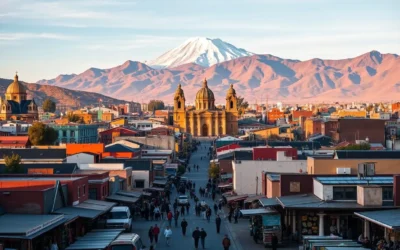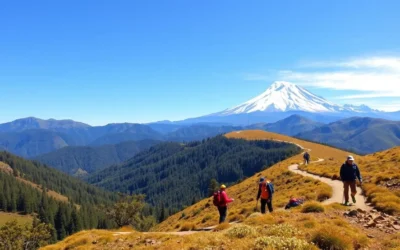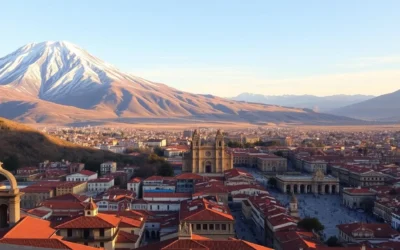✓ Accommodations ✓ Flights ✓ Rental Cars
At an astonishing altitude of 12,500 feet, Lake Titicaca is not only a breathtaking natural wonder but also a site of deep cultural significance.
Straddling the border between Peru and Bolivia, this vast body of water is considered the birthplace of the sun in Inca mythology.
As the world’s highest navigable lake, it offers a unique experience, from exploring floating reed islands to visiting ancient archaeological sites.
Whether you’re drawn to the South America’s rich history or the stunning landscapes, Lake Titicaca promises an unforgettable journey.
Discovering the World’s Highest Navigable Lake
The world’s highest navigable lake, Lake Titicaca, is a marvel of nature and a treasure trove of cultural heritage. As you explore this magnificent body of water, you’ll uncover the rich history and mythology that surrounds it.
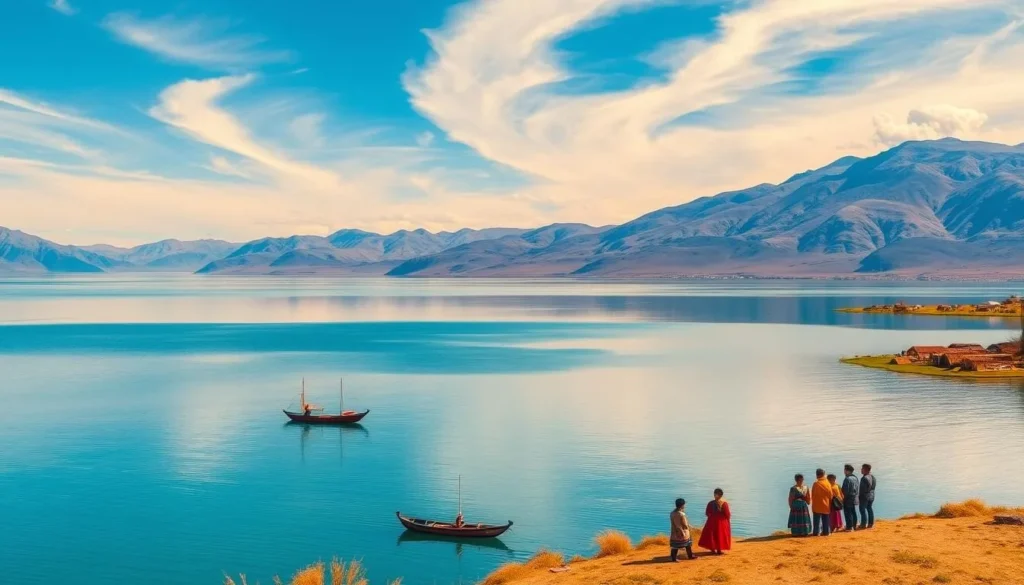
Geography and Location of Lake Titicaca
Lake Titicaca is situated high in the Andes mountains, straddling the border between Peru and Bolivia. At an altitude of 12,507 feet (3,812 meters) above sea level, it’s not only a breathtaking sight but also a challenging destination to reach. The lake’s deep blue waters cover an area of approximately 3,200 square miles (8,300 square kilometers), making it the largest lake in South America by volume.
| Geographical Feature | Description | Statistic |
|---|---|---|
| Altitude | Above sea level | 12,507 feet |
| Surface Area | Approximate area covered by water | 3,200 square miles |
| Volume | Largest lake in South America by volume | 893 cubic kilometers |
The Cultural Significance of Lake Titicaca
Lake Titicaca holds immense cultural significance for the indigenous Aymara and Quechua people who live around its shores. According to Inca mythology, Viracocha, the creator god, emerged from the lake’s waters to create the sun, moon, stars, and the first humans. This legend has made Lake Titicaca a sacred site, attracting both tourists and pilgrims from around the world.
The lake has shaped the way of life, traditions, and cultural practices of local communities for thousands of years. You can experience this rich cultural heritage firsthand by visiting the communities around the lake, where you’ll see traditional textiles, music, and dance that have been preserved through generations.
Planning Your Visit to Lake Titicaca
To truly enjoy Lake Titicaca, understanding the best time and duration for your visit is crucial. This will help you make the most of your trip and ensure a memorable experience.
Best Time to Visit Lake Titicaca
The time you choose to visit Lake Titicaca can significantly impact your experience. The dry season, from May to October, is generally considered the best time to visit, with clear skies and comfortable temperatures. However, this is also the peak tourist season, so you can expect more crowds. If you prefer fewer tourists, the shoulder season (April to May or September to November) can offer a good balance between pleasant weather and smaller crowds.
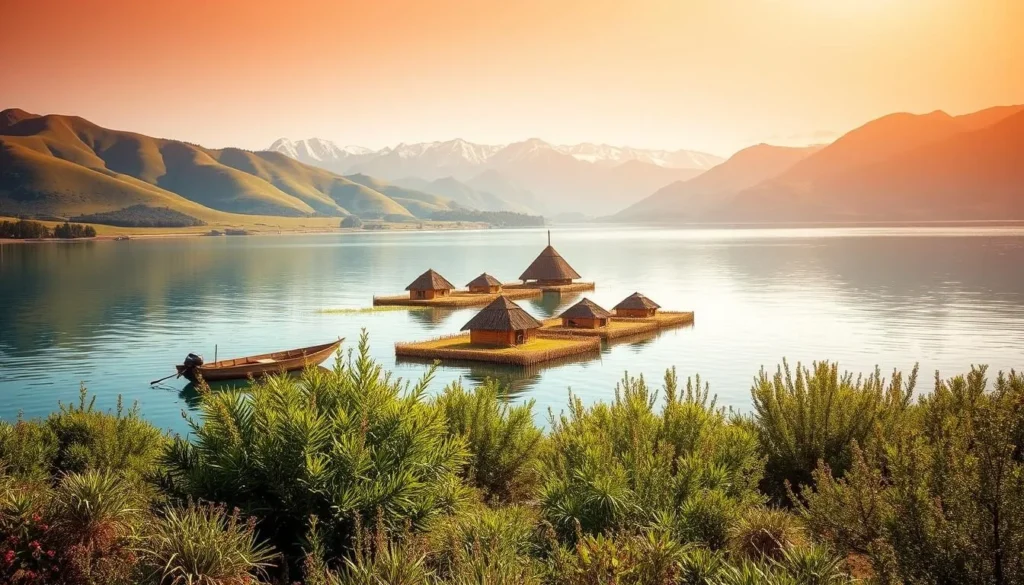
How Many Days to Spend at Lake Titicaca
Determining how many days to spend at Lake Titicaca depends on your travel style and what you want to achieve. If you’re short on time, you can still get a glimpse of the lake’s beauty in 2 days. However, to fully immerse yourself in the local culture and explore the surrounding islands, consider spending at least 4 to 5 days.
- Allocate at least 2-3 days for a basic Lake Titicaca experience, visiting essential sites like the Uros floating islands and Taquile Island.
- For a more comprehensive experience that includes both the Peruvian and Bolivian sides of the lake, consider spending 4-5 days.
- Remember, the first day of your trip may be spent traveling and acclimatizing to the high altitude, so plan accordingly.
By planning your visit carefully, you can ensure a rewarding and enjoyable experience at Lake Titicaca.
How to Get to Lake Titicaca
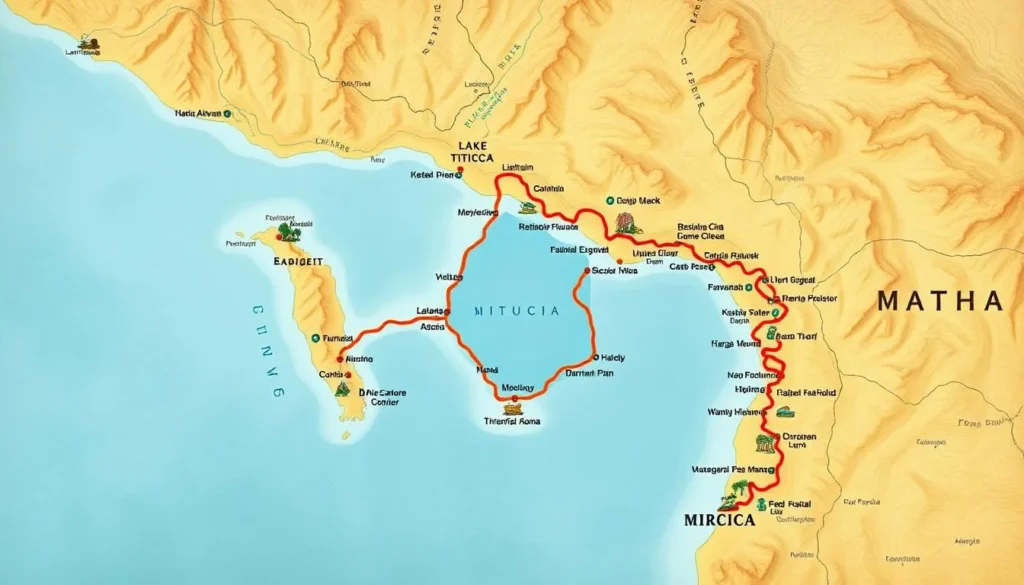
Getting to Lake Titicaca requires some planning, but the scenic views along the way make it worthwhile. You have several options to choose from, depending on your starting location, budget, and preferred mode of travel.
Arriving by Air
The fastest way to reach Lake Titicaca is by flying into Juliaca Airport, which is the closest airport to Puno, the city on the shores of Lake Titicaca. From there, you can take a taxi or shuttle to your final destination.
Traveling by Bus
For a more budget-friendly option, consider traveling by bus. Several bus companies operate from major cities like Cusco and Arequipa to Puno. The journey can be long, but it’s a great way to see the Andean landscapes.
Taking the Scenic Train from Cusco
For a luxurious and scenic experience, take the train from Cusco to Puno aboard the PeruRail Titicaca train. This 10.5-hour trip is through stunning Andean landscapes, offering gourmet meals and panoramic views. Trains leave in the morning between 7 and 8 AM. Tickets start at around $270 USD for standard service, and you can opt for the ultra-luxurious Belmond Andean Explorer for an overnight journey.
- Experience one of South America’s most scenic train journeys.
- Prepare for a luxury experience with gourmet meals and panoramic views.
- Plan your day around the morning departure from Cusco.
- Book your tickets well in advance, especially during high season.
When planning your trip to Lake Titicaca, consider the time it takes to travel and the hours you’ll spend on the journey. Whether by air, bus, or train, the trip is an adventure in itself.
Exploring the Floating Islands of Uros
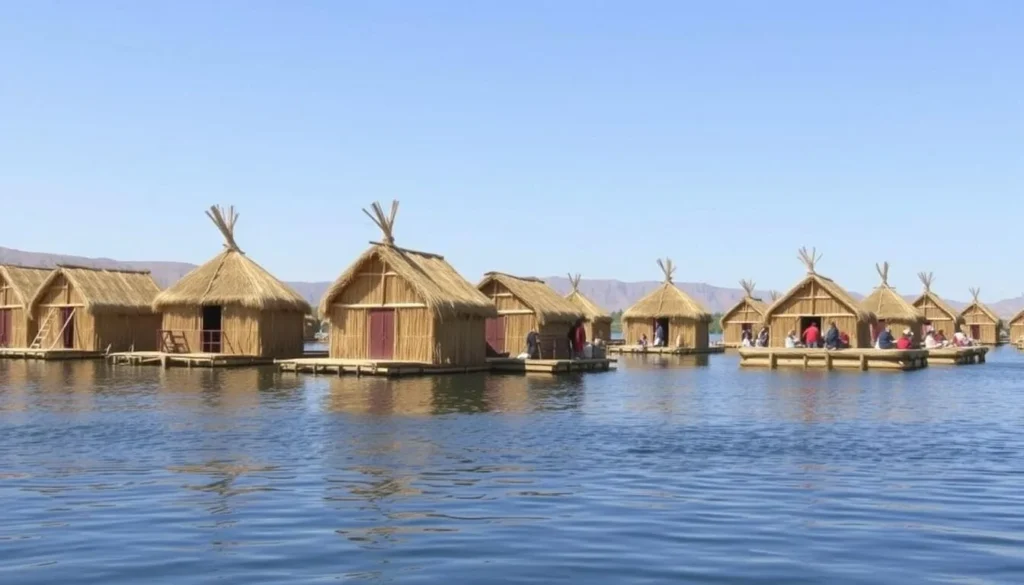
Discover the fascinating world of the Uros people on the floating islands of Lake Titicaca. The Uros floating islands are a marvel of traditional craftsmanship and a must-visit attraction on your journey to Lake Titicaca.
The History and Construction of the Reed Islands
The Uros islands are an extraordinary example of human ingenuity, with over 80 artificial floating islands made entirely of totora reeds. Each island is home to at least one family and a chief, with some larger islands featuring community buildings like schools and churches. The construction of these islands is a testament to the resourcefulness and cultural heritage of the Uros people.
What to Experience on the Uros Islands
Visiting the Uros islands is a unique cultural experience. You can explore some of the 80+ artificial islands, take a ride on a traditional totora reed boat for approximately 10 soles, and purchase colorful handcrafted souvenirs directly from the islanders. The islands are located just 20-30 minutes by boat from Puno, making them an ideal stop on your tour of Lake Titicaca. Consider an overnight stay at one of the islands’ homestays or the Uros Titicaca Lodge for a more immersive experience.
To make the most of your visit, remember that agencies manage the rotation system for visiting the different islands, ensuring that everyone has an income. This system allows you to experience the unique lifestyle of the Uros people while supporting their local economy.
Visiting Taquile Island and Its Textile Traditions
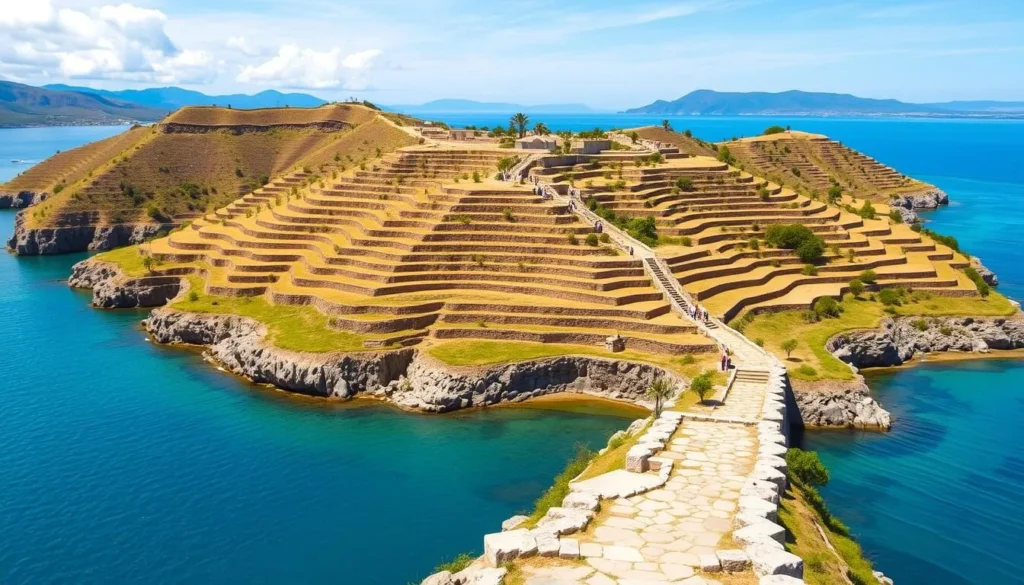
Taquile Island, with its breathtaking views and traditional textile art, is a must-visit destination on your Lake Titicaca journey. The island is renowned for its vibrant cultural heritage and stunning natural beauty.
UNESCO-Recognized Textile Art
The islanders are skilled artisans, known for their ancestral weaving techniques that have been passed down through generations. You can observe local artisans at work in the handicraft market in the Plaza de Armas, where they create beautiful textiles, including the characteristic chullo (Andean cap) and belts.
Hiking and Panoramic Views on Taquile
Taquile Island offers several hiking trails that crisscross the island, providing spectacular panoramic views of Lake Titicaca’s deep blue waters and distant snow-capped Andean peaks. You can:
- Hike to the island’s highest point at Mulsina Pata, an ancient ceremonial site with breathtaking 360-degree views.
- Explore the island’s unique agricultural terraces, built by pre-Inca civilizations.
- Visit the main plaza and its handicraft market to purchase authentic textiles directly from local artisans.
- Stroll along the peaceful beaches of Collota and Huayllano, appreciating the tranquility and natural beauty of Lake Titicaca.
As you explore Taquile Island, you’ll discover the rich cultural significance of this Lake Titicaca gem, making your journey even more memorable.
Experiencing Local Life on Amantaní Island
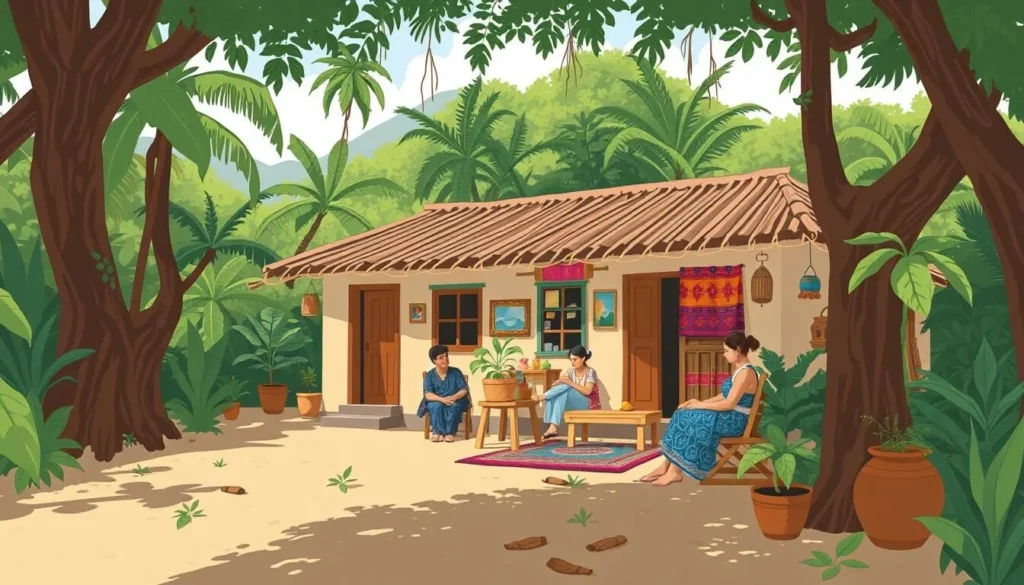
Amantaní Island homestays provide an unforgettable opportunity to engage with local families and their rich cultural heritage. By staying with a resident family, you gain a unique insight into the daily life of island residents. Enjoy a warm welcome and home-cooked meals prepared with locally grown potatoes, grains, and vegetables.
Climbing Pachatata and Pachamama Hills
During your stay, you can hike to the tops of Pachatata and Pachamama hills, which offer breathtaking views of Lake Titicaca and the surrounding landscape. These hills are not only significant for their panoramic views but also hold spiritual importance for the local community.
Participating in Traditional Music and Dance
One of the highlights of your homestay experience is participating in an evening celebration with your host family. You’ll be dressed in traditional clothing, including colorful skirts for women and ponchos for men, and join in traditional dances accompanied by local musicians playing panpipes, drums, and charangos. This experience allows you to appreciate the vibrant culture of Amantaní Island and understand the significance of music and dance in preserving cultural identity.
The homestay experience on Amantaní Island is a chance to immerse yourself in the local way of life and connect with the people who call this island home. Through this experience, you’ll gain a deeper appreciation for the traditions and customs that make Lake Titicaca such a unique and fascinating destination.
By choosing a homestay on Amantaní Island, you’re supporting the local community and contributing to the preservation of their cultural heritage. This authentic experience will leave you with lasting memories of your time on the island and a newfound respect for the culture and traditions of the region.
Lake Titicaca, Bolivia: Best Things to Do Beyond the Main Islands
The true essence of Lake Titicaca can be found in its lesser-known areas, where the rhythm of traditional life remains unchanged. While the main islands attract a fair share of tourists, there are plenty of opportunities to explore the uncharted territories surrounding this majestic lake.
Exploring the Capachica Peninsula
The Capachica Peninsula is a hidden gem that offers a serene and authentic experience. Unlike the crowded islands, this peninsula is relatively untouched by mass tourism, allowing visitors to enjoy a peaceful atmosphere. You can explore the local villages, witness traditional farming practices, and enjoy the stunning views of Lake Titicaca.
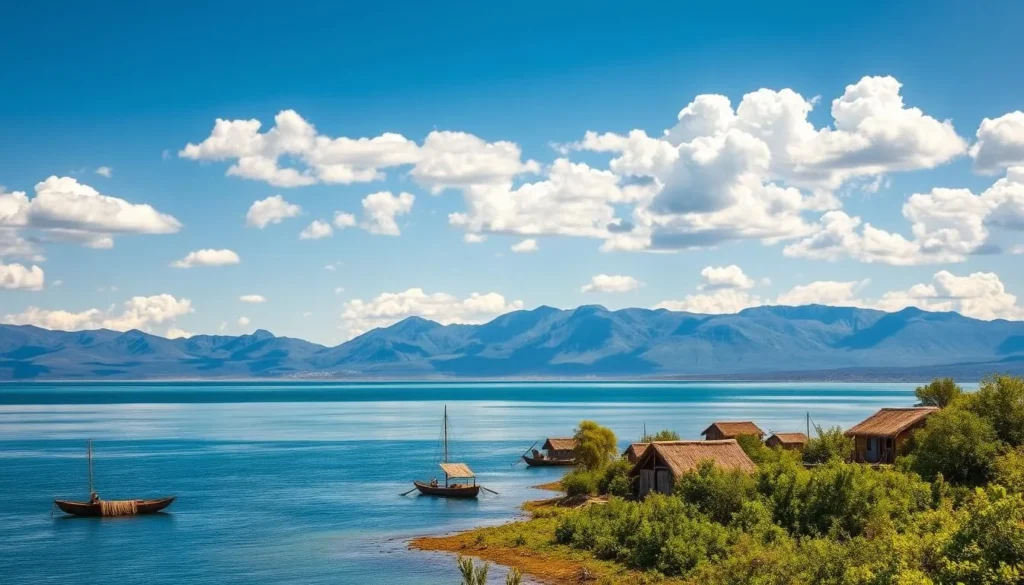
| Location | Activities | Best Time to Visit |
|---|---|---|
| Capachica Peninsula | Hiking, Village Exploration | Dry Season (May – October) |
| Uros Titino Islands | Floating Island Tour, Fishing | Year-Round |
Discovering the Less-Visited Uros Titino Islands
For a more secluded experience, head to the Uros Titino Islands, a group of floating reed islands that are less frequented by tourists. These islands are home to between 3 and 8 families, offering a glimpse into traditional life on the lake. You can learn about the construction and maintenance of these unique islands, observe daily life, and enjoy the serene atmosphere.
Key Highlights of Uros Titino Islands:
- Experience the peaceful ambiance of the islands with fewer tourists.
- Learn about traditional reed island construction from local families.
- Observe daily life and fishing practices on the islands.
Combining a visit to the Uros Titino Islands with stays in nearby Taquile Island or the Capachica Peninsula can provide a comprehensive and off-the-beaten-path Lake Titicaca experience.
Immersive Cultural Experiences: Homestays with Local Families
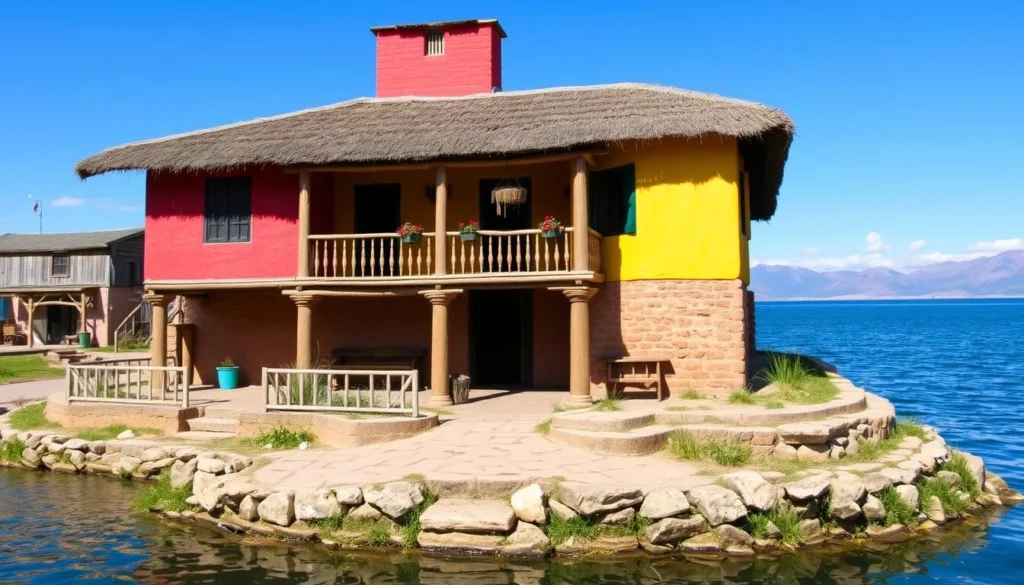
Immerse yourself in the traditional way of life on Lake Titicaca through a homestay experience with local communities. This unique opportunity allows you to live with local families, sharing in their daily activities and gaining a deeper understanding of their culture.
What to Expect During a Homestay
During your homestay, you can expect to be welcomed into the home of a local family, where you’ll participate in daily activities such as farming, fishing, or traditional crafts. You’ll have the chance to learn about the local customs, try traditional foods, and even join in on local dances or music. Many homestays offer simple but comfortable accommodations, sometimes with private bathrooms and hot water, providing a genuine experience of local life.
Best Communities for Authentic Homestays
Several communities around Lake Titicaca offer authentic homestay experiences. Consider Amantaní Island for its well-established homestay program, where families have been hosting visitors for decades and often include cultural performances in the evening. The Capachica Peninsula communities, such as Llachón, Paramis, and Chifrón, offer less touristy homestay options with beautiful lakeside settings and agricultural activities. For a slightly more comfortable stay, Luquina Chico on the Chucuito Peninsula provides homestays with better amenities, including private bathrooms and hot water. For a truly off-the-beaten-path experience, look into the remote island of Ticonata or the communities of the Socca Peninsula.
Each of these communities offers a unique glimpse into the life and traditions of the people living around Lake Titicaca, making your homestay experience truly unforgettable.
Archaeological Sites Around Lake Titicaca
As you explore the surroundings of Lake Titicaca, you’ll discover a wealth of archaeological sites that reveal the rich cultural heritage of the region. The lake’s unique location has made it a hub for various cultures throughout history, leaving behind a legacy that can be seen in its many ruins and historical sites.
Exploring the Chullpas of Sillustani
The Sillustani archaeological site is one of the most famous around Lake Titicaca, known for its impressive chullpas or burial towers. These structures, built by the Colla and Inca civilizations, are a testament to the engineering skills of these ancient cultures. As you walk through the site, you’ll be struck by the intricate stonework and the serene surroundings.
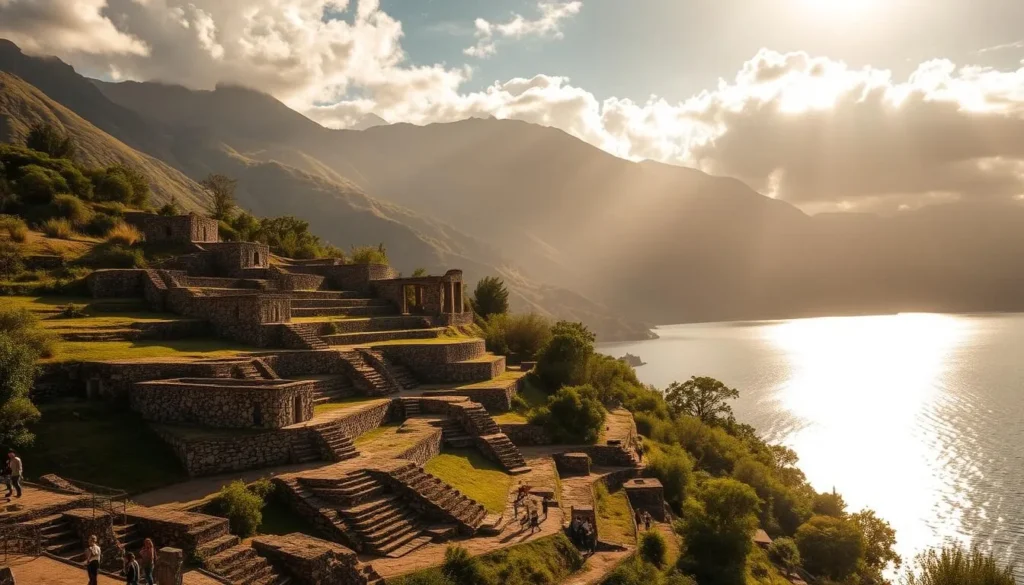
Visiting the Ancient Ruins of Cutimbo
If you’re looking for a less touristy alternative to Sillustani, consider visiting Cutimbo, located about 25 miles southwest of Puno. This site boasts well-preserved chullpas from the Lupaca, Colla, and Inca cultures, offering a unique glimpse into the region’s pre-Columbian past. The site’s long history is evident in its cave paintings, which date back approximately 8,000 years, and the unfinished chullpas that were still being constructed when the Spanish arrived.
Key highlights of Cutimbo include:
- Observing the architectural differences between circular, rectangular, and square chullpas.
- Discovering evidence of the site’s long occupation, including ancient cave paintings.
- Noticing the unfinished chullpas that reveal the impact of the Spanish conquest.
- Enjoying the peaceful atmosphere and spectacular views from the elevated plateau.
Crossing to the Bolivian Side: Copacabana
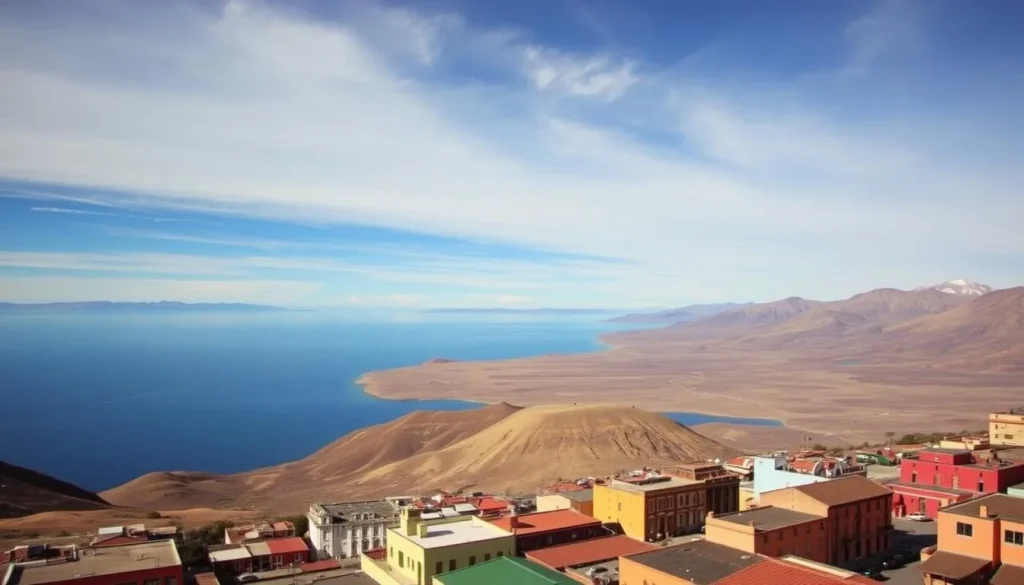
Your Lake Titicaca adventure isn’t complete without visiting the Bolivian side, particularly the charming town of Copacabana. As you cross the border from Peru into Bolivia, you’ll discover new experiences and breathtaking views.
Top Attractions in Copacabana
Copacabana is a treasure trove of attractions, including the stunning Basilica of Our Lady of Copacabana, a beautiful Catholic church that dominates the town’s skyline. You can also visit the vibrant local markets, where you can find unique handicrafts and try traditional Bolivian cuisine.
The town offers breathtaking views of Lake Titicaca, and on a clear day, you can see the majestic Illampu and Illimani mountains in the distance.
How to Cross the Peru-Bolivia Border
Crossing the Peru-Bolivia border is relatively straightforward, but it can be time-consuming. You can take a direct bus from Puno to Copacabana, which stops at the border for immigration formalities. Ensure you have all necessary documentation, including your passport, any required visas for Bolivia, and your Peru exit card.
Be prepared for a time change when crossing from Peru to Bolivia, as Bolivia is typically one hour ahead. It’s also a good idea to have some Bolivian currency (bolivianos) ready for your arrival in Copacabana.
By taking a Lake Titicaca Catamaran Tour, you can enjoy a unique experience while crossing the border. This tour allows you to appreciate the beauty of Lake Titicaca from a different perspective.
The Mystical Isla del Sol in Bolivia
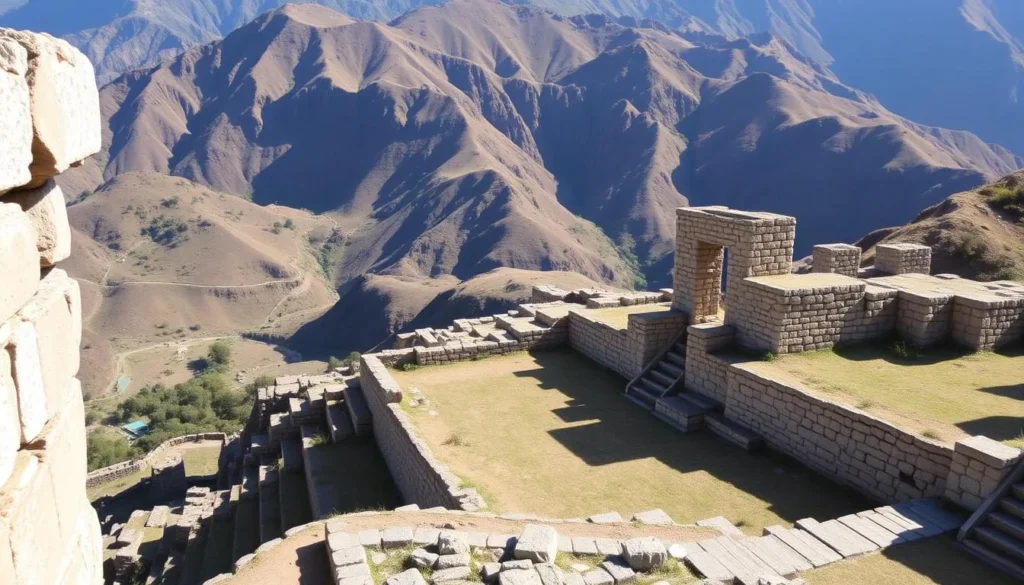
As you step onto Isla del Sol, you’re transported to a world where Inca mythology and stunning vistas await. This mystical island in Lake Titicaca is a treasure trove of cultural heritage and natural beauty, making it a must-visit destination for any traveler.
Inca Mythology and Sacred Sites
Isla del Sol is steeped in Inca mythology, believed to be the birthplace of the sun god. The island is home to numerous sacred sites, including ancient ruins and temples that reflect its rich cultural history. Visitors can explore these historical sites, immersing themselves in the island’s spiritual significance.
Hiking Trails and Panoramic Views
The island offers several hiking trails that provide breathtaking panoramic views of Lake Titicaca and the surrounding landscape. One of the most popular trails is the ancient Inca path that runs along the spine of the island, connecting the northern and southern parts. Hikers can enjoy stunning views of the deep blue waters of the lake against the backdrop of the snow-capped Cordillera Real mountains.
Some of the top experiences on Isla del Sol include:
- Hike the ancient Inca trail that runs along the spine of Isla del Sol, connecting the northern and southern parts of the island through a spectacular 3-4 hour walk.
- Experience breathtaking panoramic views of Lake Titicaca‘s deep blue waters contrasting with the snow-capped peaks of the Cordillera Real mountains in the distance.
- Climb to the island’s highest point at Cerro Uma Qolla for a 360-degree vista that helps you understand why the Incas considered this island the birthplace of their sun god.
- Navigate the network of pre-Columbian stone paths that crisscross the island, passing through traditional communities where life continues much as it has for centuries.
- Stay overnight in one of the simple guesthouses in Yumani (south) or Challapampa (north) to experience the island’s magical atmosphere after day-trippers have departed.
Outdoor Activities on Lake Titicaca
With its crystal-clear waters and breathtaking scenery, Lake Titicaca is an ideal destination for those looking to engage in outdoor adventures. The lake offers a variety of activities that allow you to experience its natural beauty and rich cultural heritage.
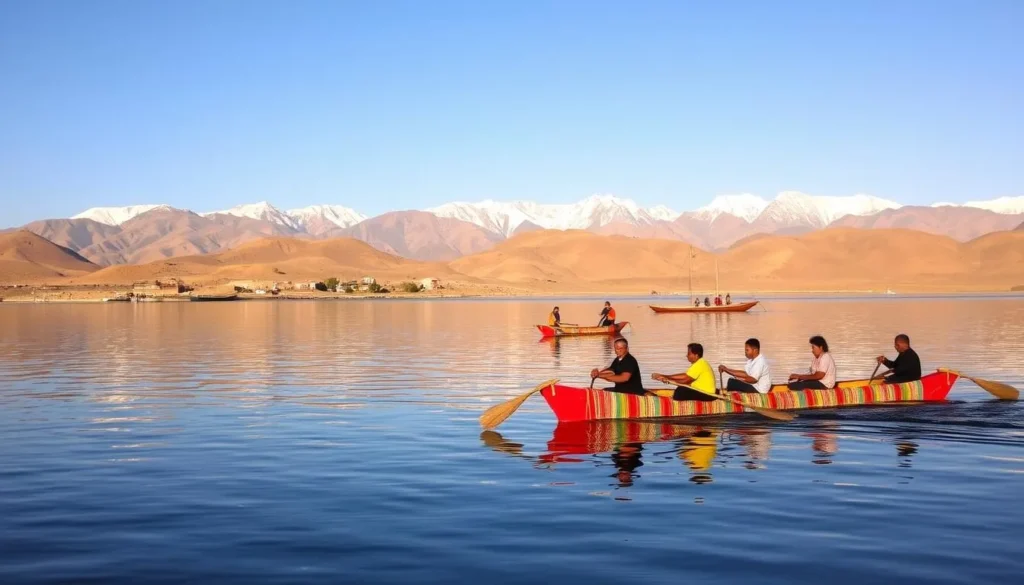
Kayaking on the Lake
Kayaking on Lake Titicaca is a serene way to explore the lake’s calm waters and get up close to the local wildlife. You can paddle through the totora reeds, visit secluded coves, and enjoy the tranquility of the lake’s surroundings. Many tour operators offer guided kayaking tours, which provide a unique perspective on the lake’s ecosystems and the communities that depend on it.
Key kayaking experiences include:
- Exploring the Uros Floating Islands and learning about the traditional construction methods used by the local inhabitants.
- Paddling to less-visited areas of the lake, such as secluded bays and inlets.
- Observing local birdlife and other wildlife in their natural habitats.
Boat Tours and Fishing Experiences
Lake Titicaca is also a great destination for boat tours and fishing experiences. You can take a traditional totora reed boat tour from the Uros Islands, experiencing the same watercraft design that has been used on the lake for thousands of years. For the more adventurous, joining local fishermen on an early morning fishing expedition can be a thrilling experience, using traditional techniques to catch native species that inhabit the lake’s high-altitude waters.
Popular boat tour options include:
- Private boat tours to explore remote areas of the lake at your own pace.
- Specialized sunrise or sunset boat tours that showcase the dramatic lighting on the water and surrounding mountains.
- Multi-day boat tours that include overnight stays on different islands, allowing you to experience the changing character of the lake from morning to night.
Whether you choose to kayak, take a boat tour, or go fishing, Lake Titicaca offers a range of outdoor activities that cater to different interests and preferences, ensuring a memorable experience on this majestic lake.
Experiencing Local Festivals and Traditions
The area around Lake Titicaca is a treasure trove of cultural experiences, with its people celebrating their heritage through numerous festivals and customs. You can witness the vibrant culture firsthand by participating in local festivals and traditions that are an integral part of life around Lake Titicaca.
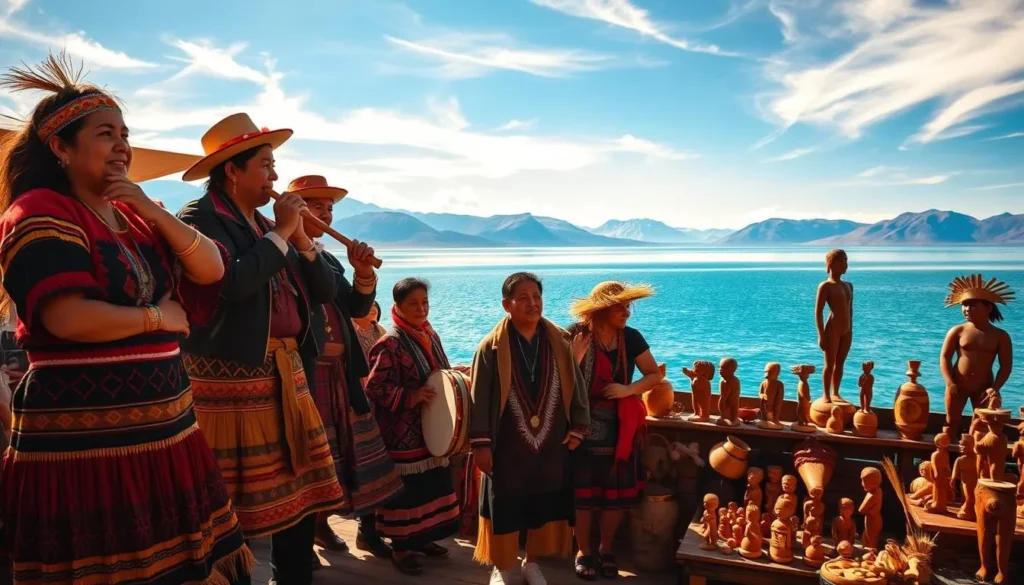
The Vibrant Virgen de la Candelaria Festival
One of the most significant festivals in the region is the Virgen de la Candelaria Festival, celebrated with great fervor in February. This festival is a spectacular display of traditional Andean music and dance, featuring elaborate costumes and choreographed performances. The festival honors the Virgin of Candelaria, a revered figure in the region, and is a testament to the community’s strong cultural heritage.
During the festival, you can experience the rich traditions of the local community, including the iconic Diablada (Dance of the Devils), Morenada, and Sikuris dances. These dances are not just entertaining performances but also carry significant cultural and historical importance, telling stories of historical events, spiritual beliefs, and daily life.
Traditional Music, Dance, and Folklore
Traditional Andean music is characterized by distinctive instruments like the zampoña (pan flute), quena (Andean flute), charango (small guitar), and bombo (drum). These instruments create the region’s characteristic sound, which is an integral part of the cultural identity around Lake Titicaca. You can experience this music during various festivals and celebrations throughout the year, each offering a unique glimpse into the community’s rich cultural traditions.
The local community takes great pride in preserving their cultural heritage, and by participating in these festivals, you can gain a deeper understanding of their way of life. The cultural expressions around Lake Titicaca are not merely performances for tourists but are living traditions that strengthen community bonds and preserve ancestral knowledge across generations.
Where to Stay Around Lake Titicaca
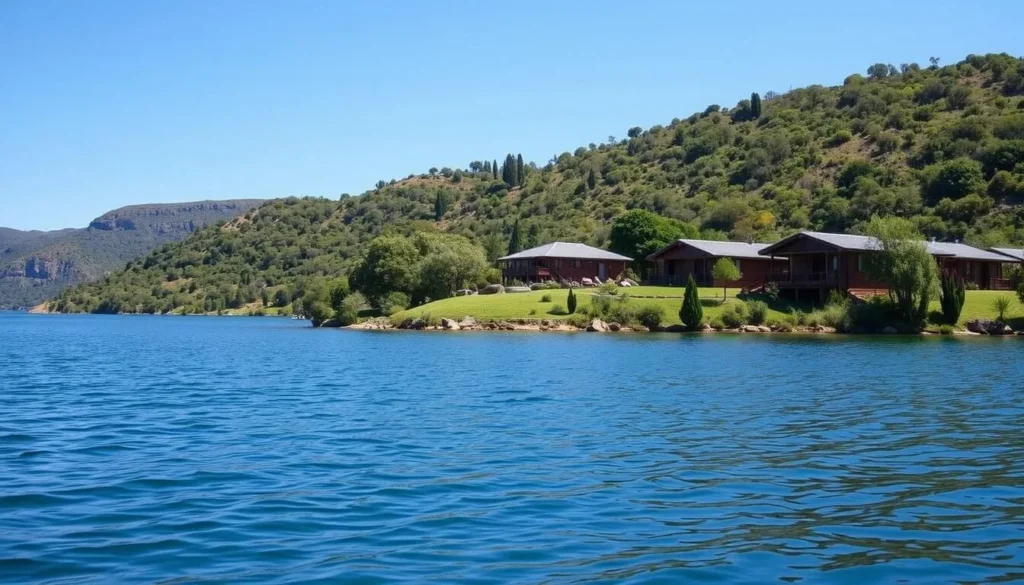
To fully immerse yourself in the beauty of Lake Titicaca, consider staying in one of its charming accommodations. The area offers a range of options, from luxurious resorts to authentic homestays, ensuring that there’s something for every traveler’s taste and budget.
Accommodations in Puno
Puno, the city on the shores of Lake Titicaca, offers a variety of accommodations that cater to different needs. While Puno itself is a bustling city, its hotels provide a comfortable base for exploring the lake and its islands. You can choose from budget-friendly options to more luxurious hotels, all within easy reach of the lake’s main attractions.
Unique Lodging Options on the Islands
For a more immersive experience, consider staying on one of the islands. The Uros Titicaca Lodge is a top pick, offering the unique chance to sleep on a floating island. Alternatively, you can opt for a homestay on Amantaní or Taquile islands, living with local families and experiencing traditional Andean life firsthand. Other options include eco-lodges on the Capachica Peninsula and the exclusive Isla Suasi Hotel, known for its tranquility and sustainable practices.
Some of the top recommendations include:
– Experiencing the unique sensation of sleeping on a floating island at the Uros Titicaca Lodge.
– Choosing a homestay on Amantaní or Taquile islands for an authentic cultural immersion.
– Booking an eco-lodge on the Capachica Peninsula for comfortable rooms with spectacular lake views.
– Considering the exclusive Isla Suasi Hotel for its solar power, beautiful gardens, and tranquility.
– Staying at one of the boutique hotels on Isla del Sol in Bolivia for stunning sunrises and sunsets.
Practical Tips for Visiting Lake Titicaca
Before embarking on your Lake Titicaca adventure, familiarize yourself with these crucial travel tips to ensure a smooth and enjoyable journey.
Dealing with Altitude Sickness
At over 12,500 feet above sea level, Lake Titicaca’s high altitude can cause sickness in some travelers. To mitigate this, drink plenty of water, avoid strenuous activities for the first few days, and consider taking altitude sickness medication if you’re particularly sensitive.
What to Pack for Your Trip
Packing the right gear is essential for a comfortable trip. Protect yourself from the intense high-altitude sun with proper sun protection, including sunblock, a wide-brim hat, and sunglasses. Additionally, bring motion sickness medication if you’re prone to seasickness, as boat rides on Lake Titicaca can be choppy.
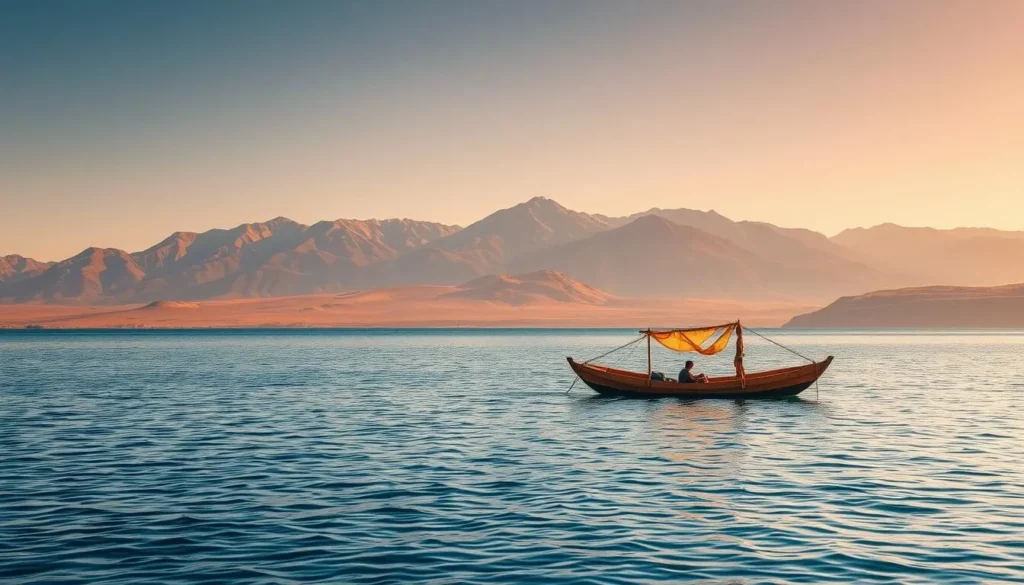
Safety and Health Considerations
To stay safe and healthy, follow these guidelines:
- Drink only bottled or purified water to avoid stomach issues.
- Be cautious with street food to prevent stomach discomfort.
- Carry a basic first aid kit, as medical facilities are limited outside of Puno.
- Be aware of your surroundings in crowded tourist areas to avoid petty theft.
By taking these precautions, you can enjoy yourtravelto Lake Titicaca on both sides of the lake, including theboatrides to the various islands.
Conclusion: Making the Most of Your Lake Titicaca Adventure
To truly make the most of your time at Lake Titicaca, consider exploring both the Peruvian and Bolivian side of this majestic lake. Your experience will be enriched by the diverse landscapes, cultures, and historical sites on offer.
As you plan your trip, remember to embrace the slower pace of life around Lake Titicaca. This allows you to truly connect with local communities and appreciate the stunning natural beauty of this high-altitude wonder. Balance your itinerary between popular destinations like the Uros floating islands and less-visited gems.
By participating in community-based tourism initiatives, you can make your trip more meaningful while directly benefiting local families. This approach provides authentic cultural exchanges and supports the local economy. Take your time to soak in the experiences, and be respectful of the traditional ways of life. Lake Titicaca is a unique place in the world, offering a transformative experience that will stay with you forever.
The above is subject to change.
Check back often to TRAVEL.COM for the latest travel tips and deals.



